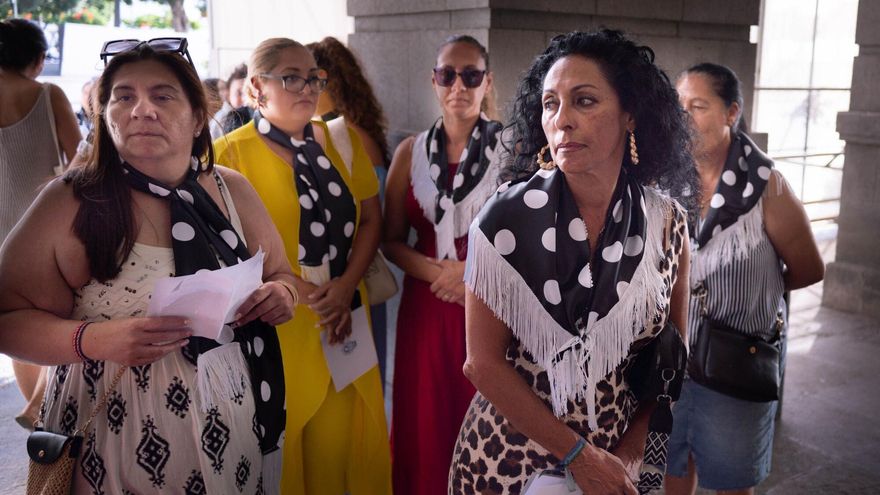
«Health and freedom, the most Romani thing in the world». This is how journalist and writer Joaquín López Bustamante ends his weekly programme on RNE dedicated to the community in Spain. Yesterday, this message in Romani, sestipen thaj mestipen, resonated strongly, with the Cabildo de Tenerife as the backdrop. The Romani flag was displayed prominently on both the facade and entrance of the Insular Palace to honour the victims of the Samudaripen, the Great Massacre in Sinti, the genocide perpetrated by the Nazis during World War II.
But there was also a reference to the attempts at extermination on a national scale, namely the Great Round-Up of the 18th century, as well as the ongoing persecution and discrimination faced in some European countries where anti-Gypsyism prevails.
A representation of the approximately 3,000 Romani people on the island attended the event to read a manifesto that advocates for the past and the present “against hate, intolerance, and barbarism”. Special thanks were given to the only public institution in the Archipelago that commemorates a day of infamy such as this.
The event was attended by the Island Councilors for Social Action, Águeda Fumero, and Culture, José Carlos Acha, along with members of the groups that are part of the Island Romani Table, who read the document aloud. Special mention was made of José Carmona, president of the sociocultural Federation E Rroma Va (Gypsies yes), and Josefa Santiago, 32 years old—who still gets nervous when it’s her turn to speak—leading the association of Romani Women in Tenerife, Romí Camela Nakerar, which means The woman wants to speak.
Community on the Island
The Romani community on the island celebrates its day on 8 April, but this August commemoration is growing in significance.
The number of active members is increasing. Those 3,000 individuals mentioned are integrated into around 450 families concentrated in areas such as La Cuesta in La Laguna (150), Granadilla-Arona (150), or Añaza in Santa Cruz (100). They primarily engage in street vending and retail. Markets, such as those in the capital, are vital meeting points for the Romani people of Tenerife.
Nothing to celebrate
The consensus was clear yesterday: “It is not a day of celebration”, but a commemoration of what must never recur, the genocide of a people persecuted throughout the centuries. In the face of “hate and intolerance”, there is a need for “diversity and human rights” to end discrimination in society. Carmona reminded us that “a society that does not know its history is condemned to repeat it”. He insisted that “we must know ours because it is that of Spain”. He valued “the resilience of those who have allowed us to be here today”.
Homage
Councillor Fumero dedicated a remembrance, as a form of homage, to the victims of the Romani genocide during an event that, she assured, “recognises and remembers the tragedies and sufferings that have marked our shared history”. She highlighted the commitment of the Cabildo de Tenerife to memory, dignity, and respect for all communities. She concluded: “It is essential to keep the memory alive and to educate future generations in values of coexistence, justice, and peace.”
Genocide
The primary aim was to remember that on the night of 1 to 2 August 1944, more than 4,000 people were massacred in the Auschwitz-Birkenau concentration camp, as part of the mass extermination process carried out by Nazism. This genocide was not recognised until 1982. It resulted in the extermination of between 25% and 50% of the European Romani population. Official figures speak of around 220,000 mortal victims, although other estimates reach up to one million people killed.
Extermination
However, yesterday was not just a commemoration of the Nazi genocide of Romani people but also of that suffered in Spain, where this 2025 is dedicated to the community, marking 600 years of their presence on the Iberian Peninsula. Specifically, the historical episode of 30 July 1749, known as the Great Round-Up or the General Prison of Gypsies, was recalled, a project conceived and led by Zenón de Somodevilla y Bengoechea, Marquess of Ensenada, an enlightened minister under King Fernando VI.
Empowered
The Cabildo entrance was filled yesterday with women of all ages who radiated activity and nerves because the event had a distinctly matriarchal sense; they were the focal point and, moreover, empowered.
They were adorned with their characteristic and assertive blue polka-dotted scarf, a badge of identity, which they later gifted to the councillor. Josefa Santiago described them as “transmitters of fire” and “the velvet hand that raises our children as we were raised”.
She referred to the words of a Romani person in Auschwitz to frame what they endured and the day itself: “If God exists, He must ask me for forgiveness.”
In feminine
Daniela, Yurena, Remedios, Juana, Vicenta, Adela, Josefa… One by one, they read their part of the manifesto. Only two men, José Carmona and Juan Antonio Santiago, broke the female monopoly for a few minutes. The best way to conclude this report is as it began: “Health and freedom” or Sestipen thaj mestipen.
Subscribe to keep reading















